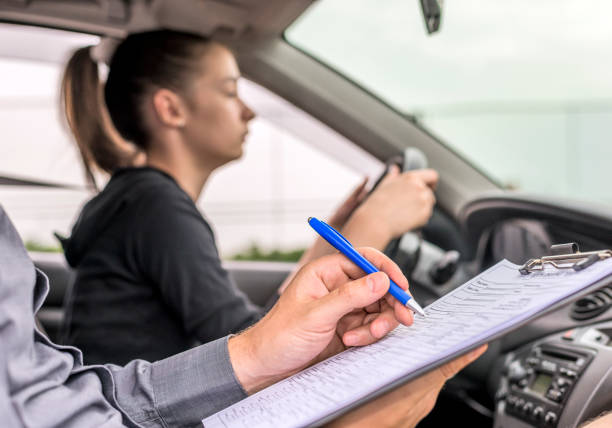Passing your driving test is an important milestone that allows you to drive independently and responsibly. However, many learner drivers find the driving test marking scheme difficult to understand. Knowing how examiners assess your performance can make the process less intimidating and help you prepare with confidence.
This guide by Aram Driving explains every aspect of the UK driving test marking scheme. It covers how faults are assessed, what counts as a minor or major fault, and how examiners apply the test criteria. You will also find practical tips to help you avoid common mistakes and achieve a confident, safe driving performance.
Overview of the UK Driving Test
The driving test in the UK is designed to ensure that every driver is competent, safe, and ready to handle real-world road conditions. The test assesses both your theoretical knowledge and practical driving skills.
1. Theory Test
Before taking your practical driving test, you must pass the theory test. It includes two main parts:
- Multiple-choice section: This part evaluates your understanding of The Highway Code, traffic signs, and road safety rules. You must answer 50 questions and achieve a minimum score of 43 to pass.
- Hazard perception section: You watch video clips and identify developing hazards. This measures how quickly and accurately you can respond to potential risks.
2. Practical Driving Test
The practical test is where you demonstrate your ability to drive safely and independently. It usually lasts around 40 minutes and includes several components:
- Eyesight check – Reading a vehicle number plate from 20 metres away.
- Vehicle safety questions – Answering ‘show me, tell me’ questions to prove basic car knowledge.
- General driving – Following directions on various road types.
- Independent driving – Driving for 20 minutes using road signs or a sat-nav.
- Manoeuvres – Performing one manoeuvre, such as parallel parking or reversing into a bay.
What Is the Driving Test Marking Scheme?
The driving test marking scheme is the system used by examiners to assess your driving performance. It records any mistakes you make, known as faults, under three categories: minor, major (serious), and dangerous.
Purpose of the Marking Scheme
The marking scheme ensures fairness and consistency in every test. It helps examiners judge your ability to drive safely and independently under various road conditions.
Main Assessment Areas
Examiners assess your driving under several key areas, as shown in the table below:
| Assessment Area | Description |
| Control | Smooth use of the clutch, gears, steering, and brakes |
| Observation | Awareness of surroundings, mirrors, and signals |
| Manoeuvres | Ability to perform parking, turning, and reversing tasks safely |
| Speed Control | Maintaining safe and appropriate speeds for road conditions |
| Road Positioning | Correct lane use and vehicle positioning |
| Awareness | Anticipating potential hazards early |
| Safety | Ensuring the safety of yourself and others |
The examiner evaluates your performance based on how well you meet the official test criteria in each of these areas.
Understanding Minor and Major Faults
The difference between minor and major faults is central to understanding the marking scheme. Examiners use these classifications to determine whether your driving meets the required safety standards.
Minor Faults
A minor fault (also known as a driving fault) is a small mistake that does not create a danger. You can accumulate up to 15 minor faults and still pass your test, provided none of them develop into a serious issue.
Examples of minor faults include:
- Forgetting to check mirrors before changing direction.
- Late signalling before a turn.
- Rough gear changes.
- Slightly inaccurate parking.
- Hesitating unnecessarily at a junction.
While minor faults don’t cause immediate failure, repeatedly making the same mistake may show a pattern of weakness and lead to a major fault.
Major Faults
A major fault (sometimes called a serious or dangerous fault) is a mistake that compromises safety. Even one major fault results in automatic failure.
Common examples of major faults include:
- Failing to stop at a red traffic light.
- Not giving way at a junction.
- Entering a roundabout without checking for oncoming traffic.
- Driving too close to another vehicle.
- Losing control of the car during a manoeuvre.
The distinction between minor and major faults is crucial because it shows how much risk a particular mistake introduces.
| Fault Type | Definition | Result |
| Minor | Small mistake without immediate danger | Up to 15 allowed |
| Major | Mistake posing a potential risk | Immediate fail |
| Dangerous | Mistake creating direct danger | Immediate fail |
How the Examiner Scores the Test
The examiner records your performance on a digital report form. Each fault is classified as minor, serious, or dangerous. The total number and severity of faults determine whether you pass or fail.
Scoring Criteria
- Minor faults: These show lapses in skill or judgement but not dangerous behaviour.
- Serious faults: Mistakes that could potentially cause danger.
- Dangerous faults: Mistakes that create immediate risk to road safety.
If you accumulate more than 15 minor faults or commit one major or dangerous fault, you will fail the test. The examiner will review your results immediately after the test, explaining each fault and area of improvement.
Common Faults Learners Make
Many learners fail the driving test due to simple, preventable errors. Recognising these issues in advance can help you avoid them.
Frequent Mistakes:
- Failing to check mirrors before changing direction.
- Incorrect positioning on roundabouts.
- Poor observation at junctions.
- Driving too close to other vehicles.
- Failing to respond to road signs.
By practising regularly and staying aware, you can reduce these errors and meet the test criteria more effectively.
Tips to Avoid Common Mistakes
1. Stay Calm and Focused
Feeling nervous during the test is natural. Use deep breathing to calm your nerves, and focus on one step at a time.
2. Maintain Good Observation
Always check mirrors before any change in speed or direction. Examiners observe whether you use mirrors effectively throughout.
3. Control Your Speed
Adhere to the speed limit, but also adjust according to traffic and weather conditions. Driving too fast or too slow can result in faults.
4. Practise Manoeuvres Thoroughly
Spend time perfecting parking, reversing, and turning. Smooth control and accuracy are signs of competence.
5. Listen Carefully
If you don’t understand an instruction, ask politely for clarification. Examiners prefer you confirm rather than make a mistake.
6. Anticipate Hazards
Identify potential risks early. For example, look ahead for pedestrians, cyclists, or parked vehicles that may require action.
7. Learn from Feedback
After driving lessons or mock tests, discuss feedback with your instructor. Focus on improving weak areas instead of repeating errors.
Preparing for the Practical Test
Preparation plays a big role in your success. You can increase your confidence and performance by following a structured plan.
Step-by-Step Preparation:
- Take Mock Tests – Simulate real test conditions to become comfortable with the format.
- Review The Highway Code – Refresh your understanding of traffic rules and road signs.
- Practise Different Routes – Drive in urban, rural, and motorway conditions for versatility.
- Get Enough Rest – Being well-rested helps you stay alert and responsive.
- Organise Your Documents – Carry your provisional licence and theory test certificate on test day.
Consistency and regular practice are key to meeting the test criteria successfully.
Final Thoughts
Understanding the UK driving test marking scheme helps you feel prepared and confident on test day. Knowing how faults are scored and what examiners look for gives you the knowledge to perform better and avoid unnecessary mistakes.
Driving examiners want to see that you can handle real-world traffic safely and responsibly. By practising regularly, maintaining good observation, and staying calm under pressure, you can meet all the test criteria and pass successfully.
Passing your test is not about perfection – it’s about proving you can drive safely, make good decisions, and respect others on the road. With preparation and focus, you’ll soon earn the freedom of driving confidently across the UK.
If you’re ready to start your driving journey, contact us today to book your lessons and get expert guidance every step of the way.
Frequently Asked Questions (FAQs)
How many minor faults can I have and still pass?
You can have up to 15 minor faults and still pass your driving test. However, if the same type of fault occurs repeatedly, it could be marked as a serious fault.
What happens if I make a major fault?
A major fault means your action could endanger safety. Even one major fault leads to failure, but you can retake the test after more practice.
How long does the driving test take?
The practical test takes around 40 minutes. It includes general driving, independent navigation, and one manoeuvre such as reversing or parking.
What’s the difference between a serious and dangerous fault?
A serious fault shows a potential risk to safety, while a dangerous fault means your action caused immediate danger. Both result in an automatic fail.
How will I receive my result?
You’ll receive your result immediately after the test. The examiner will explain each fault and suggest what to improve before your next attempt.
What are the best ways to prepare?
The best way to prepare is to practise consistently, study the driving test marking scheme, and focus on eliminating repeated minor errors. Familiarise yourself with the test criteria and stay confident.








